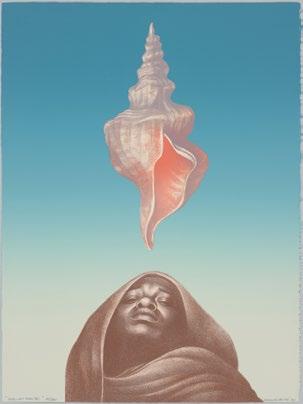
2 minute read
Charles Wilbert White, Jr. Kehinde Wiley

A love letter to nature, Charles Wilbert White, Jr.’s color lithograph depicts a moment of bliss as the central, hooded figure gently leans her head back as if to bask in the light reflected from a conch shell which floats over her head. The conch shell is a repeating element in White’s art practice, as a symbolic representation of feminine lifeforce and creativity. Paired with the cloaked figure, it makes the image a double celebration of Black womanhood. Against the vivid turquoise background, the shell and woman also evokes Mami Wata, the pantheon of water spirits venerated in West, Central, and Southern Africa. The water deity became a powerful figure within the African diaspora in the Americas. Love Letter III shows equilibrium and balance between people and the environment restored in an image of hope and serenity.
The poses of the two young men in Marechal Floriano Peixoto II are adapted from two figures at the base of a famous monument dedicated to the military marshal and second President of Brazil, Floriano Peixoto. Located in a public plaza in Rio de Janeiro, the statue shows the standing figure of a Catholic priest presenting a crucifix to a young girl, presumably Indigenous. Colonialism has long been associated with religion in Brazil, and directly linked to territorial domination. In contrast to the statue, Wiley’s monumental painting entwines the locals with regional flowers, and the standing figure holds not a cross, but a bamboo reed, a plant native to the Brazilian rainforest. Both figures gaze directly at the viewer, rather than down at the ground, and their calm presence suggests strength, pride and comfort in a gentle integration with the natural world that permeates the scene.











